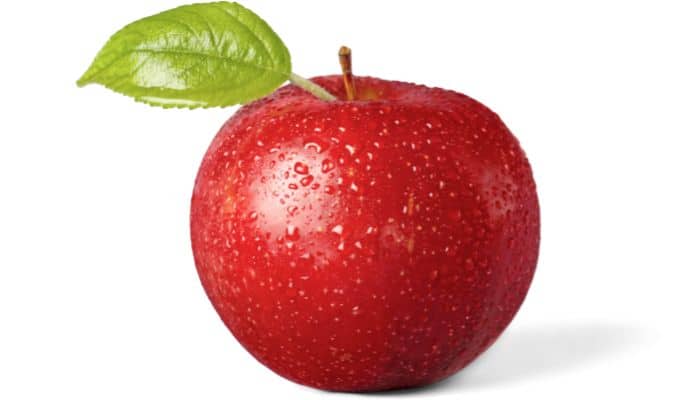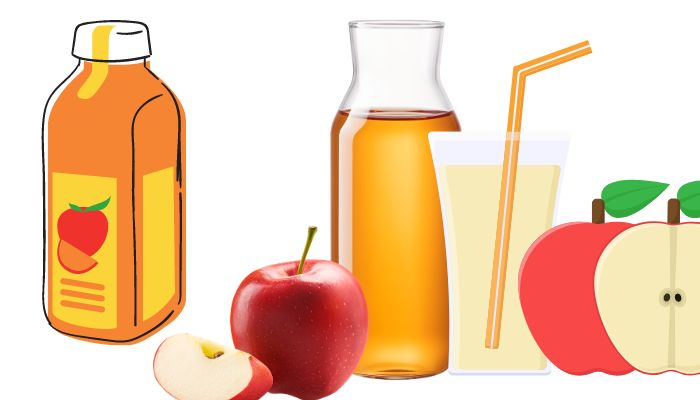The Nutritional Benefits of Apples: Why it’s a Great Fruit to Add to Your Diet

Read more:
The History of Apples as a Fruit
The apple, that crisp, juicy, and versatile fruit, holds a rich and fascinating history. Derived from the wild species Malus sieversii, apples have been enjoyed by humans for thousands of years.
The ancient Romans, Greeks, and Egyptians all valued the apple, but it was the Romans who were the first to cultivate this fruit in Europe and Asia. The Romans adored apples and even had a goddess of apples and apple orchards, Pomona.
With the advent of the Roman Empire, apples spread throughout Europe and Asia. The apple tree was among the earliest to be cultivated, and its fruits have been improved through selection over thousands of years.
“The apple tree was among the earliest to be cultivated, and its fruits have been improved through selection over thousands of years.”
By the Middle Ages, apples were being grown in many regions of the world. Monks in medieval monasteries cultivated orchards and experimented with apple varieties, leading to the development of many of the varieties we enjoy today.

The Apple in America
When European colonists arrived in North America, they brought apple seeds with them. The first apple orchard on the North American continent was planted in Boston by Reverend William Blaxton in 1625.
Over time, cultivating apples became a significant part of American culture. John Chapman, better known as Johnny Appleseed, became a legend for his role in spreading apple orchards across the Midwest in the 19th century. His efforts led to a boom in apple diversity, with thousands of unique varieties.
Today, the apple is grown in all 50 states, with the majority produced in Washington State. There are over 2,500 varieties grown in the United States alone, each with its own unique taste, texture, and color.
The history of the apple is a testament to human ingenuity and the ability to cultivate and adapt nature to our tastes. It is a story of trial and error, of discovery and innovation, all leading to the delicious and nutritious fruit we enjoy today.

Types of Apples You Need to Try
When you think of apples, the first variety that pops into your mind is likely the classic Red Delicious or maybe the tangy Granny Smith. However, the world of apples is much more diverse and fascinating than you may realize. There are literally thousands of apple varieties, each with its unique taste, texture, and color.
The Classic Red Delicious
Begin your apple exploration with the Red Delicious. Known for its deep red skin and sweet flavor, this apple is perfect for snacking and salads.
The Tangy Granny Smith
If you’re a fan of a little tang, the Granny Smith apple is for you. Its tart flavor and crisp texture make it ideal for baking, snacking, and even adding a bit of zing to your salads.
The Versatile Golden Delicious
Don’t let the similarity in the name fool you; the Golden Delicious is quite different from its red cousin. This apple has a sweet, mellow flavor and is excellent for baking, cooking, and snacking.
The Sweet Honeycrisp
The Honeycrisp is a favorite among apple lovers for its incredibly sweet flavor and crisp, juicy texture. It’s perfect for eating fresh or using in salads.
The Balanced Fuji
A balance of sweet and tart, the Fuji apple is perfect for anything. Whether you want to bake, cook, make cider, or snack, this apple has you covered.

The Spicy Pink Lady
Finally, try the Pink Lady for a unique apple experience. It has a distinctively spicy, sweet-tart flavor that works well in baking, sauces, and salads.
These are just a few examples of the many varieties of apples available. Whichever you choose, remember that each type of apple can offer a unique taste and experience. So don’t hold back, start exploring the wonderful world of apples today!
Why Apples are a Nutritional Powerhouse
Why are apples often cited as a key component of a healthy diet? This is because they are a nutritional powerhouse. Let’s dive deeper into the health benefits they offer and why you should consider incorporating them into your daily routine.
Rich in Essential Nutrients
Apples are packed with a multitude of vitamins and minerals that are essential for our health. This includes vitamin C, which supports immune function, and potassium, a heart-healthy mineral. They’re also a good source of fiber which aids in digestion and helps you feel full, making them an excellent snack for weight management.
Apples as a fruit
Antioxidant Powerhouse
Apples are rich in antioxidants, including quercetin, catechin, and chlorogenic acid. These compounds help combat oxidative stress in the body, protecting against chronic illnesses such as heart disease and cancer.
Hydration
Did you know that apples are about 85% water? This makes them a great option for staying hydrated, especially on hot days or after a workout.

Low in Calories, High in Fiber
Despite their sweet taste, apples are low in calories and high in dietary fiber. A medium-sized apple, for instance, contains about 95 calories but 4 grams of fiber. This combination can help keep you satiated without overloading on calories.
Beneficial for Bone Health
Studies suggest that the type of antioxidants found in apples, particularly the flavonoid phloridzin, may positively impact bone density and overall bone health. This, together with their high vitamin C content, makes apples an excellent fruit for maintaining strong and healthy bones.
Whether enjoyed as a crunchy snack, a sweet dessert, or an ingredient in a savory dish, apples are a nutritional powerhouse that brings a wealth of health benefits to your table. So go ahead, bite into that juicy apple knowing it’s doing your body good.
Fun Facts about Apples You Probably Didn’t Know
Did you know that apples are not just delicious, but they are also packed with fun and intriguing facts? Let’s uncover some apple trivia that will surely surprise you.
- Home to a world of apples: There are over 7,500 varieties of apples around the globe. That’s a lot of apples to try!
- Apples float because 25% of their volume is air. This makes them perfect for the popular game of ‘apple bobbing’ on Halloween.
- Apples are a member of the rose family. Yes, you read that correctly. Apples are indeed related to ornamental flowers like roses and cherries.
More about Apples as a fruit
- The science of apple cultivation is called pomology. If you love apples, maybe this could be your next career move!
- Apples can wake you up better than coffee: They contain about 13 grams of natural sugar and are packed with several B vitamins that can give you a natural energy boost.
- The largest apple ever picked weighed an impressive 4 lbs 1 oz, that’s almost the same weight as a healthy newborn baby!
So, next time you bite into a crunchy apple, remember these fun facts and impress your friends with your newfound apple knowledge.

How Apples are Grown and Harvested
Have you ever wondered how your favorite fruit, the apple, is grown and harvested? It’s a fascinating process that combines modern technology with traditional agricultural methods.
Planting and Growing
Apple trees are grown from seedlings, which are young trees that have already started to sprout from a seed. These seedlings are typically grown in a nursery until they are strong enough to be transplanted into an orchard.
Once planted, apple trees need a lot of care and attention. They require plenty of sunlight and water to grow properly. In addition, farmers use various horticultural techniques to ensure their healthy development. For instance, pruning, or the act of selectively removing branches, is a common practice that helps to improve the tree’s form and increase fruit production.
Apple Blossoms and Pollination
Springtime brings with it a beautiful sight in apple orchards, as trees are covered with pink and white apple blossoms. These flowers are not just there for show – they play a crucial role in the production of apples. Bees and other pollinators are attracted by the flowers and, as they move from one flower to another, they carry pollen with them. This pollination process is necessary for the apples to form.
The Harvesting Process
Apples are typically ready for harvest in the fall. The exact timing varies depending on the apple variety and the climate in the growing region. Farmers use a few different methods to determine whether their apples are ready for harvest. They might look at the apple’s color, size, and taste, as well as how easily it can be detached from the branch.
When it comes to harvesting the apples, it’s usually done by hand to avoid damaging the fruit. Workers must be careful not to bruise the apples, as this can lead to faster spoilage. Once picked, apples are stored in cool, controlled environments to maintain their freshness until they’re ready to be shipped to stores.
So, the next time you bite into a crisp, juicy apple, remember the journey it has taken from the orchard to your hand. It’s a process that requires time, patience, and a lot of care, but the result is certainly worth it!
Apples as a fruit
The Best Apple Recipes You Need to Make Today
If you’re seeking inspiration for incorporating apples into your meals, you’ve come to the right place. Here are some delicious apple recipes you need to try today. These recipes will surely delight your taste buds and make you appreciate the versatility of this amazing fruit.
Classic Apple Pie
There’s nothing more comforting than a piece of warm apple pie. This traditional dessert is a delightful mixture of sweet and slightly tart apples, cinnamon, nutmeg, and a flaky crust. Serve it with a scoop of vanilla ice cream for an ultimate treat.
Apple Cider Donuts
Embrace the flavors of fall with these mouth-watering apple cider donuts. They are crispy on the outside, soft on the inside, and bursting with the flavors of apples and spices. These donuts make a perfect breakfast treat or a scrumptious dessert.
Apple Crisp
Apple crisp is another classic dessert that showcases the deliciousness of apples. It features tender apples topped with a crumbly, buttery topping. It’s easy to prepare and guaranteed to impress your guests.
Baked Apples
If you’re looking for a healthier dessert, try baked apples. These apples are stuffed with a mixture of oats, brown sugar, and spices, and then baked until tender. They’re a great way to enjoy the sweetness of apples without the added calories.
Apple Soup
Yes, you read that right! Apple soup is a unique dish that combines sweet apples with hearty vegetables in a savory broth. This soup is comforting, nutritious, and perfect for a chilly day.
Apples are truly versatile, and these recipes are just the tip of the iceberg. So, why not head to your local grocery store, pick up some apples, and start cooking? You’ll be amazed at how this humble fruit can elevate your culinary creations.
The Role of Apples in Culture and Literature
The apple has not only made a significant impact in our diet but has also found its place in culture and literature. This humble fruit’s influence spans across different cultures, symbolizing everything from knowledge and temptation to health and beauty.
Apples in Mythology and Symbolism
In Greek mythology, apples were seen as symbols of beauty and temptation. They played a pivotal role in the story of the Trojan War. Eris, the goddess of discord, tossed a golden apple inscribed with the words “for the fairest” into a banquet of the gods, leading to a dispute that eventually caused the war.
In Norse mythology, apples were believed to keep the gods youthful. The goddess Idunn was entrusted with the apples that the gods had to eat to maintain their immortality.
Apples in Literature
Apples have often been used in literature to symbolize knowledge. One of the most notable examples is the apple in the biblical story of Adam and Eve, representing the fruit of the Tree of Knowledge.
William Tell, a Swiss folk hero, was known for his incredible accuracy with a crossbow. Legend says he was forced to shoot an apple off his son’s head, a scene that has been depicted in numerous works of literature.
In the modern era, the apple continues to make appearances. J.K. Rowling’s “Harry Potter” series features enchanted apples that bounce and spin in the Hogwarts’ Great Hall during feasts.
Apples in Cultural Celebrations
Apples also play a role in cultural celebrations. In many Western cultures, apple bobbing is a popular game during Halloween festivities, where participants try to catch floating apples in their mouths.
In China, the word for apple sounds similar to the word for peace. Thus, it’s customary to give apples on Christmas Eve, known as ‘Ping An Ye’ in Chinese, which means quiet or peaceful night.
So, as you enjoy your next apple, remember it’s not just a fruit. It’s a symbol, a literary device, and a cultural icon with a rich and diverse history.
Apples and Health: Separating Fact from Fiction
When it comes to apples and health, there’s a lot of information out there. But sometimes, it can be hard to separate fact from fiction. Let’s take a closer at some of the most common claims about apples and see what the science really says.
The Claim: “An apple a day keeps the doctor away”
This famous saying has been around for a long time, but is there any truth to it? Well, it turns out there might be. Apples are rich in dietary fiber and vitamin C, both of which are crucial for overall health. While eating an apple a day won’t guarantee you’ll never get sick, it can certainly contribute to a healthy diet and lifestyle, which may help keep illness at bay. So, this one is partly fact.
The Claim: “Apples can help you lose weight”
Apples are low in calories and high in fiber, which can help you feel full and satisfied. This can potentially lead to consuming fewer calories overall, which could aid in weight loss. But remember, apples are not a magic weight loss food. It’s always important to maintain a balanced diet and regular exercise. So again, this claim is partly fact.
The Claim: “Apples can lower the risk of heart disease”
Some studies suggest that the flavonoids found in apples may help reduce the risk of heart disease by lowering blood pressure, reducing “bad” LDL cholesterol, and fighting inflammation. However, more research is needed to fully understand the relationship between apple consumption and heart health. Therefore, this claim is possible, but not yet confirmed.
The Claim: “Apples can prevent cancer”
While it’s true that a diet rich in fruits and vegetables, including apples, can contribute to overall health and may help prevent certain types of cancer, it’s important to note that no single food can prevent or cure cancer. So, this claim is somewhat misleading.
In conclusion, while apples are undeniably healthy and can contribute to a balanced diet, they are not a cure-all. It’s always important to maintain a varied and balanced diet and seek advice from healthcare professionals when it comes to managing health conditions and disease prevention.
How to Select the Perfect Apple for Your Needs
Selecting the perfect apple to meet your culinary needs or personal preferences might seem like a daunting task considering the myriad of apple varieties that exist. However, armed with the right information, you can easily make a choice that best suits your needs. Here’s how to do it.
Consider the Variety
First and foremost, you need to consider the variety of the apple. Different varieties have unique flavor profiles, textures, and uses. For instance, if you’re baking a pie, you might want to choose a firm, tart apple like the Granny Smith. On the other hand, for a fresh, crisp snack, a sweet, crunchy Honeycrisp apple might be just the ticket.
Inspect the Appearance
The appearance of an apple can often be a good indicator of its freshness and quality. Look for apples with vibrant, unblemished skin without any cuts, bruises, or punctures. These imperfections can affect the apple’s taste and shelf life. The apple should also feel firm to the touch, not soft or spongy.
Check the Aroma
A good apple often has a fresh, sweet aroma. If it doesn’t smell like anything, it might not taste like much either. Conversely, if the apple has a sour or musty smell, it’s probably past its prime and should be avoided.
Consider the Season
While apples are available year-round, they are a seasonal fruit and different varieties have peak seasons. For example, McIntosh apples are best in the fall, while Pink Lady apples are at their prime in the late winter and early spring. Buying apples in season can often yield the best quality and flavor.
Test the Weight
Finally, give the apple a little heft in your hand. It should feel dense and heavy for its size. This is a sign the apple is juicy and not dried out.
By taking these factors into consideration, you can select the perfect apple for your needs, whether you’re making a delicious apple pie, refreshing apple cider, or simply enjoying a fresh, crisp apple as a healthy snack.
The Benefits of Eating Apples for Snacks
Eating apples as snacks isn’t just a convenient way to fend off hunger pangs, but it’s also a healthy choice that can benefit your body in numerous ways. Apples are not only delicious and varied in flavor, but they are also packed with nutrients and offer a number of health benefits. Here’s why you should consider reaching for an apple the next time you’re craving a snack.
1. Nutrient-Dense
Apples are a nutrient-dense food, meaning they are low in calories but high in essential vitamins and minerals. They are particularly rich in Vitamin C and dietary fiber, both of which are crucial for overall health.
2. Supports Digestive Health
The high fiber content in apples aids digestion and promotes a healthy gut. Eating an apple for a snack can help regulate your bowel movements and prevent digestive issues such as constipation and diarrhea.
3. Promotes Heart Health
Apples contain soluble fiber that helps lower your blood cholesterol levels. They also contain flavonoids, which are linked to lower risk of heart disease. Snacking on apples can therefore support a healthy heart.
4. Helps in Weight Management
Thanks to their high fiber content and water volume, apples can keep you feeling full longer, helping to control overeating and supporting weight management. So, if you’re trying to maintain or lose weight, an apple could be the perfect snack.
5. Boosts Immunity
The Vitamin C in apples plays a vital role in maintaining and boosting your immune system, making apples a great snack to help fend off colds and other illnesses.
6. Hydrating
Apples are about 86% water. Eating an apple can help to hydrate your body, making it an excellent snack choice, particularly during the hot summer months.
So, the next time you’re looking for a snack, reach for an apple. Not only will you be satisfying your hunger, but you’ll also be doing something great for your health. Remember, an apple a day can indeed keep the doctor away!
The Different Varieties of Apples and Their Uses
When it comes to apples, one size certainly doesn’t fit all. There are countless apple varieties, each with a unique flavor profile, texture, and color. While some apples are perfect for a quick, healthy snack, others shine when used in culinary creations. Let’s explore some of the most popular apple varieties and their uses.
Red Delicious
Regarded as the classic American apple, the Red Delicious is often a favorite in school lunch boxes due to its sweetness. It is best enjoyed fresh out of hand, but doesn’t perform as well when cooked.
Granny Smith
The Granny Smith apple’s tartness makes it a favorite for apple pies. It holds its shape well during cooking, making it ideal for all kinds of baking and cooking applications.
Golden Delicious
As its name implies, the Golden Delicious is a sweet apple. It’s versatile, performing well both when eaten fresh and in cooking. It’s particularly good in salads and apple sauce.
Honeycrisp
The Honeycrisp apple is sweet with a hint of tartness and has a crunchy texture loved by many. It’s a great apple for eating fresh or adding to salads, and it also makes delicious apple cider.
Fuji
The Fuji apple has a balanced sweet-tart flavor and is incredibly juicy. It’s a great snacking apple and also performs well when baked into desserts.
Pink Lady
The Pink Lady or Cripps Pink apple, is known for its spicy-sweet flavor. It’s an excellent apple for eating fresh, adding to salads, or using in cooking and baking.
These are just a few examples of the incredible diversity of apples available. Each apple variety brings something unique to the table, so why not try a few and find your new favorite?
The Science Behind Why Apples are Good for You
Have you ever wondered why everyone keeps telling you apples are good for you? Let’s delve into the science behind this claim. Apples, being incredibly rich in dietary fiber, vitamins, and antioxidants, have powerful health benefits. These benefits are not merely hearsay or old wives’ tales, but are backed by scientific research and studies.
The Magic of Fiber
Firstly, apples are a great source of dietary fiber. Fiber, which is a type of carbohydrate found in plant foods, is something your body can’t digest. While this may sound like a negative, it’s actually a huge positive. Fiber helps regulate your body’s use of sugars, keeping your hunger and blood sugar in check. A medium-sized apple contains about 4 grams of fiber, contributing significantly to your daily fiber intake.
Powerful Antioxidants
Besides fiber, apples are also packed with powerful antioxidants including flavonoids and vitamin C. Antioxidants are substances that protect your cells against free radicals, which are harmful molecules that can cause damage and play a role in heart disease, cancer, and other diseases. The antioxidants in apples have been linked to a reduced risk of developing cancer, hypertension, diabetes, and heart disease.
Hydration Heroes
Apples are made up of about 86% water, which can help you stay hydrated. Proper hydration is essential for all aspects of health, including maintaining a strong immune system and promoting optimal heart and brain function.
Bone Protection
Recent studies suggest that the phytonutrients and anti-inflammatory compounds found in apples could help promote bone density and strength. These compounds have been linked to an increase in bone density, beneficial for those looking to protect their bones as they age.
Support for Digestive Health
Apples contain a type of soluble fiber called pectin, which is known for its laxative effect and its ability to support a healthy gut environment. Pectin helps increase stool bulk and movement, promoting regular bowel movements and potentially preventing digestive conditions like irritable bowel syndrome, diverticulitis, and other forms of stomach discomfort.
In conclusion, the science behind apples as a health-promoting food is extensive and compelling. Incorporating apples into your diet is a simple, tasty, and effective way to give your overall health a boost.
The Most Creative Uses for Apples
When it comes to apples, you’re probably already familiar with their use in pies, salads, and as a quick snack. But the humble apple offers far more potential beyond these traditional uses. Its sweet yet tart flavor, combined with its versatile texture, makes it a perfect ingredient for a host of creative recipes and uses. Here’s a look at some of the most imaginative ways to incorporate apples into your daily routine.
Culinary Creations
Apples can be a surprising and delightful addition in savory dishes. Consider baking a whole apple stuffed with savory fillings like sausage or herbs. Or, how about making an apple and cheddar grilled cheese sandwich? The tartness of the apple perfectly complements the creaminess of the cheese. And don’t forget about beverages! Apple-infused water or apple mint iced tea can be a refreshing change from your regular drink options.
Home Decor
Believe it or not, apples can also be a part of your home decor. Hollow out an apple and use it as a candle holder for a unique centerpiece. Or, dry out apple slices and string them together to create a lovely and fragrant garland. You can even use whole apples as place card holders for your next dinner party.
Natural Cosmetics
Apples can also play a role in your beauty routine. The fruit is naturally rich in alpha-hydroxy acids, which can help exfoliate your skin. Try creating a homemade facial mask with pureed apples, honey, and oats. Apply it to your face for a refreshing and natural beauty treatment. Additionally, apple cider vinegar, made from fermented apple juice, can be used as a hair rinse to add shine and combat scalp issues like dandruff.
Composting
Even the parts of the apple you can’t eat can be put to use. Apple cores and peels can be composted to create rich soil for your garden. This is a great way to reduce waste and help your plants thrive at the same time.
So, next time you have a basket full of apples and wonder what to do with them, consider these creative uses. Beyond their delicious taste and health benefits, apples can truly be a versatile asset in many aspects of your life!
The Art of Pairing Apples with Other Foods
Pairing apples with other foods is a delightful culinary experience that opens up a world of flavors. Whether you’re looking for a refreshing salad, a warm and comforting dessert, or a savory main course, there’s an apple pair that can take your dish to the next level. Here’s how you can master the art of pairing apples with other foods.
Apple Pairings for Salads
When it comes to salads, an apple’s freshness and crispness can provide a satisfying contrast to the other ingredients. Try pairing a tart Granny Smith apple with a salty cheese like blue cheese and a hearty green like kale. Or, for a sweeter salad, pair a Honeycrisp apple with goat cheese, arugula, and a light vinaigrette.
Apple Pairings for Main Courses
In main courses, apples can add a sweet and tangy note that enhances the overall dish. For example, a Golden Delicious apple pairs well with pork, its sweetness complementing the savory meat. On the other hand, a Red Delicious apple’s mild flavor can complement chicken dishes without overpowering them.
Apple Pairings for Desserts
When it comes to desserts, apples are a classic ingredient. Their unique flavors can be enhanced by pairing them with the right ingredients. A tart apple like the Granny Smith is perfect for apple pies and tarts, as the tartness balances out the sweetness of the sugar. Pairing a sweet apple, like Fuji or Honeycrisp, with cinnamon and nutmeg creates a warm and comforting dessert.
Apple Pairings for Cheese
Apples and cheese are a match made in heaven. The sweetness of an apple perfectly offsets the creaminess of the cheese, making for a satisfying snack or appetizer. A crisp, juicy Pink Lady apple pairs beautifully with a sharp cheddar, while a sweet Gala apple is a perfect match for a creamy brie. Don’t be afraid to experiment with different combinations to find your favorite.
Apple Pairings for Beverages
Finally, apples can also be paired with beverages. Apple cider, both alcoholic and non-alcoholic, naturally complements many fall dishes. But don’t stop there. A crisp cider can also complement a robust cheese board or a rich, caramel dessert. Fresh apple juice can also be a refreshing accompaniment to breakfast or brunch dishes.
Exploring the art of pairing apples with other foods not only expands your culinary repertoire but also allows you to appreciate the versatility of this wonderful fruit. So the next time you pick up an apple, think beyond the bite and imagine the delicious pairings it can be a part of.
How to Make Your Own Apple Juice and Cider
Ever wondered how to make your own apple juice or cider? With just a few steps and the right apples, you can enjoy these delicious drinks right in your own kitchen. Not only do homemade apple drinks taste better, but they are also a healthier alternative since you control what goes in it.
How to Make Apple Juice
- Select the right apples: For a sweet juice, opt for red apples such as Red Delicious or Fuji. If you prefer a tart flavor, Granny Smith apples are a great choice. A mix of both can also create a balanced flavor.
- Wash and prepare the apples: Rinse the apples thoroughly under running water. Cut them into quarters or chunks, removing the seeds but keeping the skin on for added nutrients.
- Extract the juice: If you have a juicer, simply feed the apple chunks into the machine. If you don’t have a juicer, blend the apples in a blender and strain the puree using a cheesecloth or fine mesh strainer.
- Enjoy: You can drink the juice immediately or refrigerate it for later use. Remember, homemade apple juice contains no preservatives so it’s best to consume it within a few days.
How to Make Apple Cider
Apple cider is a bit more complex to make than apple juice since it involves fermentation. However, the rich, flavorful result is well worth the extra effort!
- Pick the right apples: A combination of sweet and tart apples typically works best for cider. You can even add a few crabapples for a more complex flavor.
- Prepare the apples: Wash them thoroughly, cut them into chunks, and remove any damaged parts. The seeds and skin can be left on.
- Press the apples: This step requires a cider press which crushes the apples and extracts the juice. If you don’t have access to a cider press, you can use a juicer or blender and strain the pulp as you would when making apple juice.
- Ferment: Pour the juice into a clean, glass fermentation vessel such as a carboy. Add cider yeast, secure the top with an airlock, and let it ferment in a cool, dark place. Fermentation can take anywhere from a week to a few months, depending on the conditions and the specific yeast used.
- Bottle and enjoy: Once fermentation is complete, the cider can be bottled and enjoyed either still or carbonated. Remember to store the cider in a cool, dark place and consume it within a year.
Creating your own apple juice and cider can be a rewarding experience. The process allows you to appreciate the fruit in a whole new way, and the end result is a delicious drink that’s filled with the natural goodness of apples. So why not give it a try today?
The Future of Apples: Innovations and Trends
As you journey through the world of apples, it’s essential to consider what the future holds for this versatile fruit. The apple industry never stops innovating, and there are several trends and advancements that you should keep an eye on.
Firstly, the apple industry is continually developing new varieties to appeal to changing consumer tastes. For instance, the EverCrisp, a cross between the Honeycrisp and Fuji, is gaining popularity for its sweet flavor and long shelf life. Meanwhile, the Rave apple, an early-season variant of the Honeycrisp, is lauded for its juicy and tart profile.
Advancements in Apple Farming
Advancements aren’t just about new varieties. Farming and harvesting methods are also evolving. Precision agriculture, which uses data and technology to improve crop yields and reduce waste, is becoming more commonplace in apple orchards. This includes GPS mapping, drone technology, and smart irrigation systems that help farmers monitor their crops in real time.
Another significant trend is the move towards organic and sustainable farming practices. As consumers become more conscious of how their food is grown, many apple growers are reducing their use of pesticides and adopting more environmentally-friendly methods.
Apples as a Fruit
Apple Products Innovation
The future of apples isn’t just about the fruit itself, but also the products made from it. Expect to see more innovative apple-based products in the market, from apple-infused skincare products to apple-based alcoholic beverages. There’s even an increasing trend of using apple peels and cores, which are typically discarded, in products like tea, snacks, and animal feed, reducing waste and promoting sustainability.
Furthermore, apples are also making their way into the tech industry. For instance, apple leather, a vegan-friendly material made from apple peels, is being used in phone cases, wallets, and even shoes.
The apple industry is ripe with innovation, showing that this humble fruit has a lot more to give. Its future is indeed exciting, and we can’t wait to see what new developments will come our way.
What Your Favorite Apple Says About You
If you’ve ever wondered what your favorite apple variety may reveal about your personality, this section was made for you! An apple’s taste, texture, and color can tell a lot about you and your preferences. So, let’s get into the fun part of decoding what your favorite apple says about you.
The Classic Red Delicious
Do you find yourself always reaching for a Red Delicious? This might mean that you appreciate tradition and have a strong connection to your roots. You are dependable, consistent, and not easily swayed by the latest trends or fads.
The Tangy Granny Smith
If you’re a fan of the tartness of Granny Smith apples, it could suggest that you are a bit of an adventurer. You are not afraid to embrace the unexpected or venture into unknown territories. You likely have a zest for life and enjoy a good challenge.
Apples as a fruit
The Versatile Golden Delicious
Golden Delicious lovers are often versatile and adaptable, much like this apple variety. You’re likely to be someone who can adjust to different situations with ease and embrace change with a positive attitude.
The Sweet Honeycrisp
If Honeycrisp is your apple of choice, you might be someone who loves comfort and indulgence. You appreciate the finer things in life and seek out experiences that provide joy and satisfaction. You’re also likely to be generous and nurturing to those around you.
The Balanced Fuji
If you prefer the balanced sweetness and tartness of a Fuji apple, it might imply that you value balance in life. You strive for harmony in all aspects of your life, from work-life balance to maintaining a balanced diet.
Apples as a Fruit
The Spicy Pink Lady
Being fond of such apples may imply that you have innate traits of audacity and mettle. Unafraid to deviate from convention, you drive your existence with autonomy. Appreciate these distinctively flavored apples while reflecting on how they parallel your captivating character traits.
After some thoughtful banter has been had… Pondering the connection between taste and personality may provide insight into who we truly are. Thus, let us eagerly anticipate unwrapping secrets regarding ourselves through the familiar experience of consuming apples!
Apples as a fruit
Don’t take umbrage over this; it’s purely tongue-in-cheek and deserves only a pinch of salt for flavor. A thought-provoking question indeed! How do our tastes relate to our personality traits? Hmm… curiosity may lead you on such paths; keep notes nearby when munching on those mouthwatering apples! Although this won’t exactly change who you fundamentally represent, learning some side insights by doing so certainly could make profound impressions regarding how much new information one can acquire regarding oneself with everyday interactions!
Apples as a Fruit







